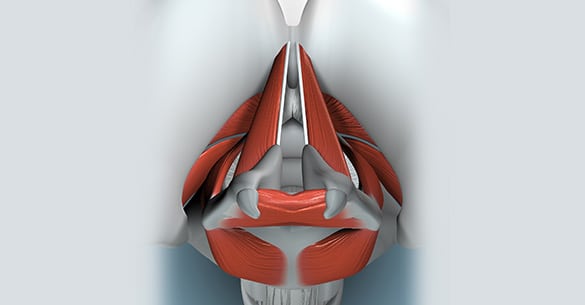
There are several options for treating vocal cord nodules.
Located within the larynx at the top of the trachea, vocal cords are designed to move to produce the vibrations necessary for speech and related sounds and tones. Sometimes, these folds of tissue develop bumps called nodules. Benign (non-cancerous) and often harmless, nodules sometimes affect the quality of the sounds produced by the vocal folds and contribute to throat and neck pain. Treatment will depend on:
- The size and location of the vocal cord growths
- The symptoms experienced
Causes of Vocal Cord Nodules
It’s usually some type of long-term vocal cord abuse or misuse that causes vocal nodules to form over time. It’s also possible to develop smaller nodules from single instances of severe vocal cord strain, like yelling at a concert. Smoking, excessive alcohol consumption, and allergies are among the factors that can contribute to the development of bumps on vocal folds.


Signs of Issues with Nodules
Most people with nodules first become aware of the problem when changes in vocal quality are noticed. For instance, you might experience hoarseness, a rough, harsh, or scratchy voice, or have a “breathy” tone to your voice. Related signs and symptoms may include:
- Shooting pain extending to the ears
- General discomfort in the neck area
- Feeling like there’s lump or obstruction in your throat
- An inability to easily change pitch or tone
- Vocal “tiredness” where the voice starts out normally and fades off
Examination and Diagnosis
If have persistent hoarseness or throat irritation for more than a few weeks, it’s best to see your doctor or a specialist. Testing can be done to evaluate your vocal quality. A procedure called a laryngoscopy may be done for diagnostic purposes to view your throat and vocal cords with a special tube that’s inserted through your mouth. A series of flashing lights produced by a stroboscope is sometimes used to observe the vocal cords as they move.
Treating Nodules
Initial treatment usually involves giving vocal cords time to rest and heal and voice therapy. It can take a while for nodules to completely go away with methods like this. If more immediate results are desired, surgery may be performed to remove the nodules. While there are some risks associated with surgical excision, less invasive techniques have made common procedures safer for most patients. Surgery isn’t usually recommended for children with vocal cord nodules.
Botox injections may be administered as an alternative to surgery. The purpose of injections is to prevent the repetitive trauma that sometimes contributes to nodule formation. There’s research suggesting steroid injections placed directly into nodules may also be effective. If underlying issues are contributing to vocal fold growths, such as thyroid problems or allergies, these medical problems will need to be addressed as well to increase the odds of enjoying a successful outcome with treatment efforts.
The most effective way to reduce your risk of developing vocal cord nodules is to use your voice wisely. Avoid extreme ranges within your voice, such as really soft whispering, speaking loudly for long periods of time, or shouting and screaming. If you regularly sing or speak to project your voice, use assistance devices like microphones, do vocal warm-ups, and use proper techniques to avoid the type of strain that often results in the inflammation and irritation that can create the perfect environment for nodules to form.


